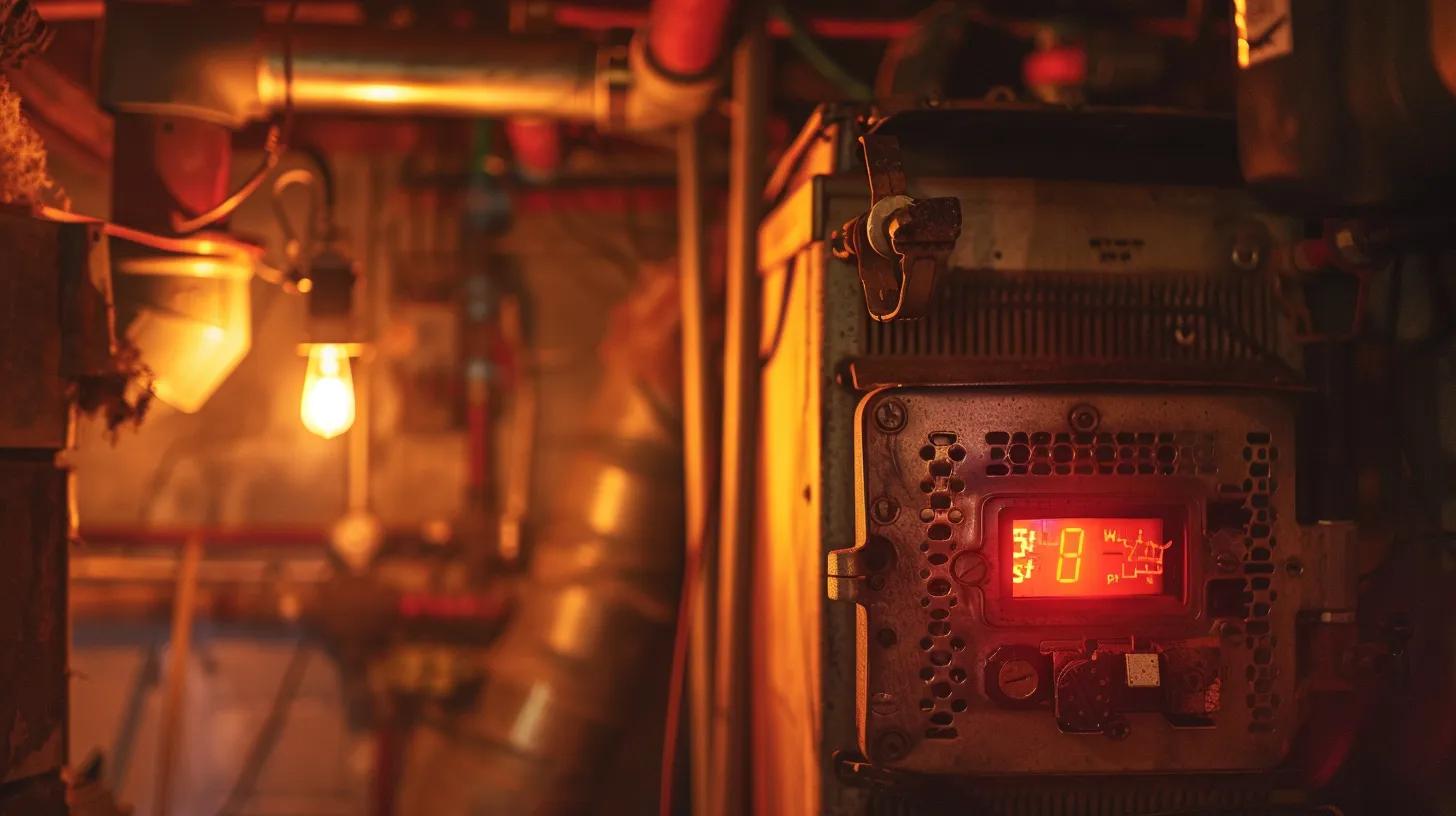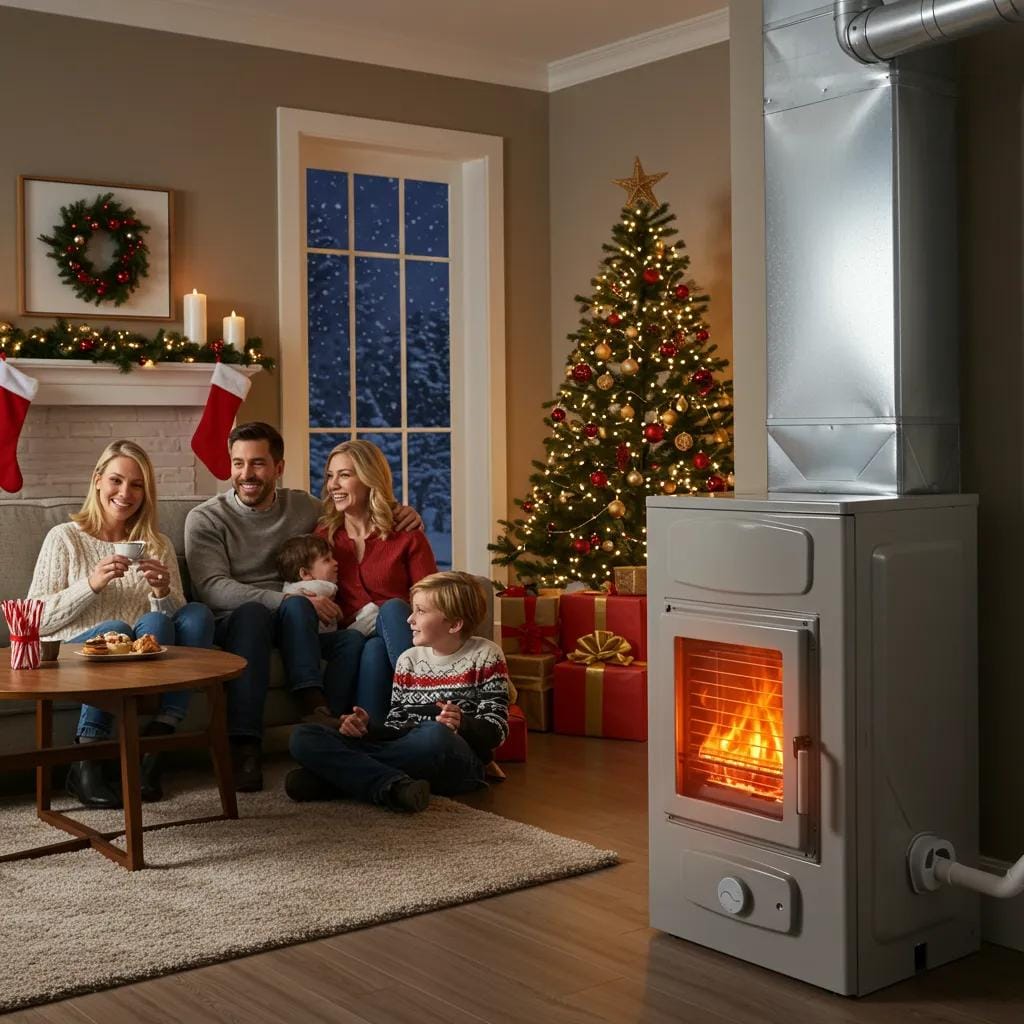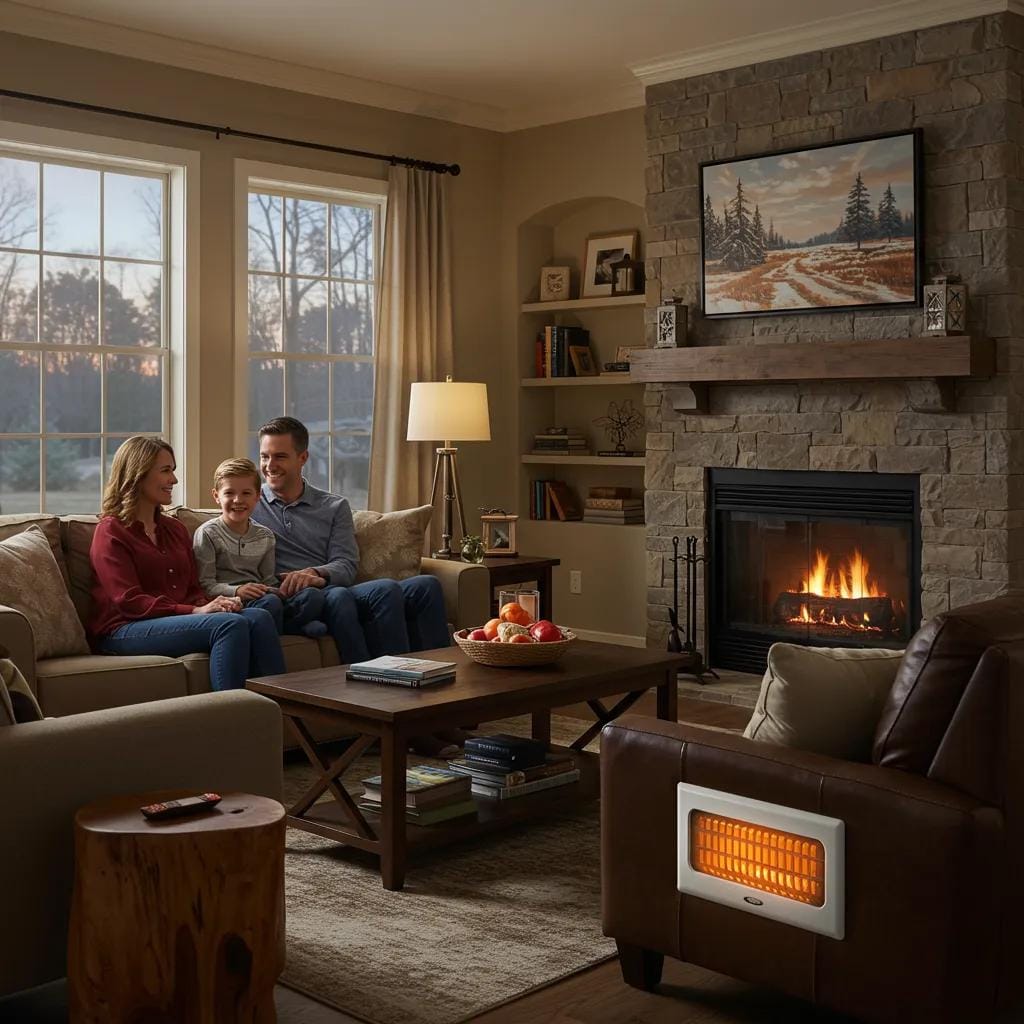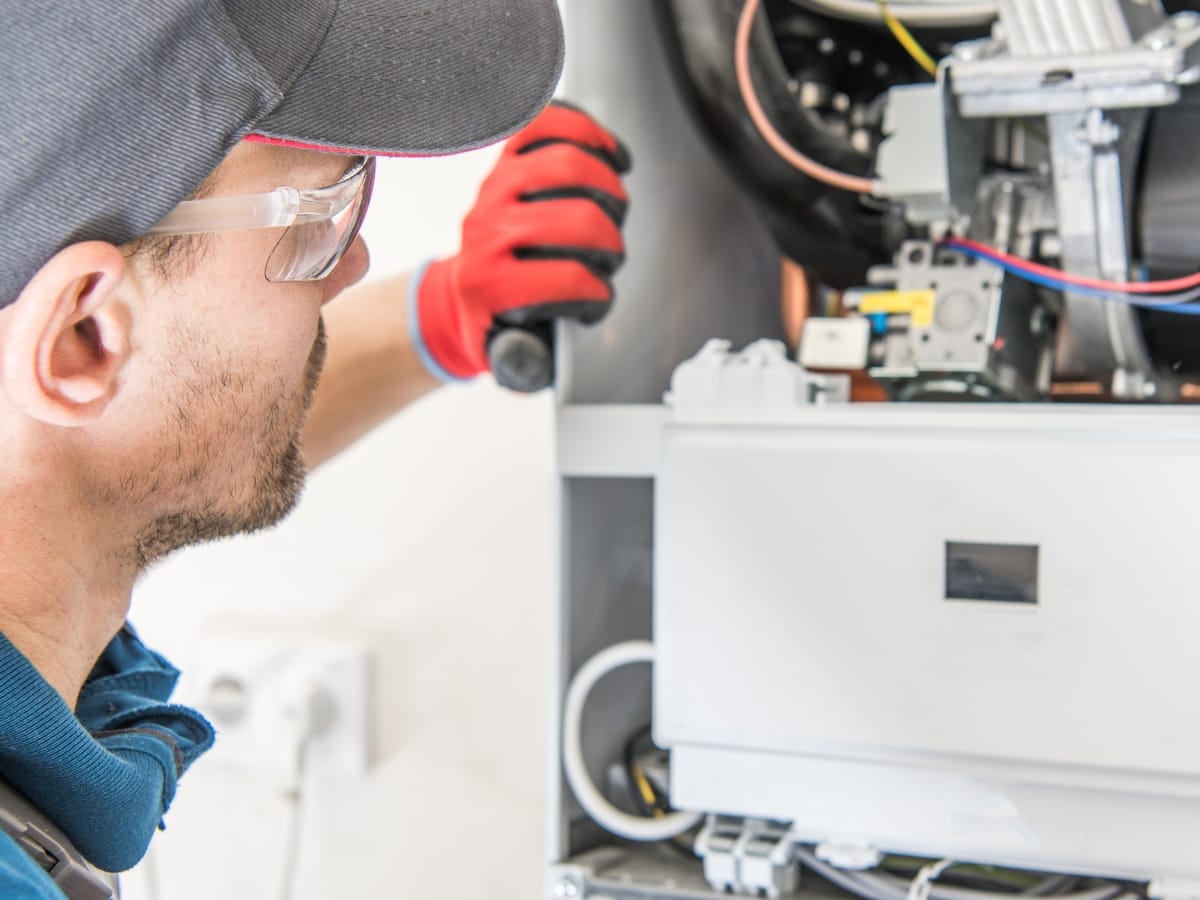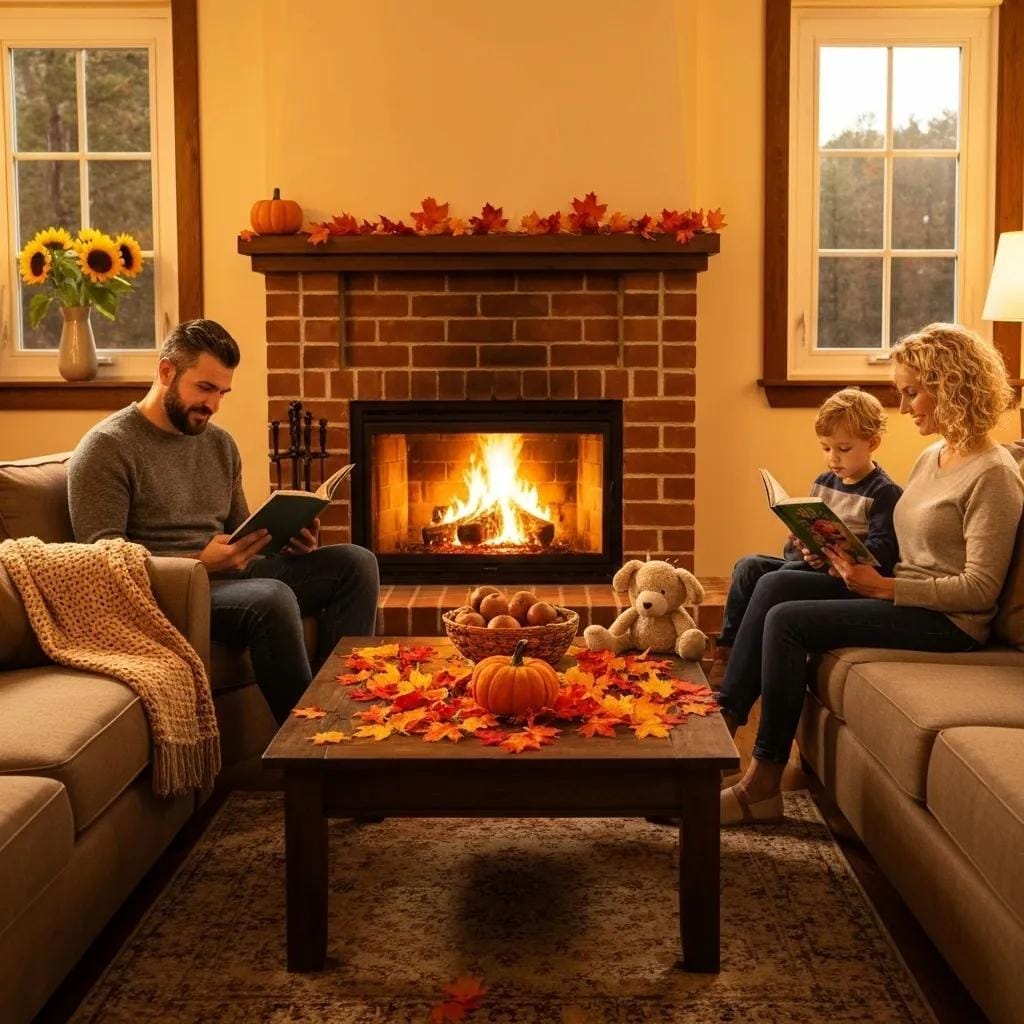Ever walked into a room expecting cozy warmth but instead, you’re greeted with a blast of cold air? That’s a sign your furnace might be waving a white flag.
In this post, we’ll dive into the telltale signs your furnace needs repair, from strange noises that should never be ignored to the subtle hints of inefficient heating performance.
We’ll also touch on the dangers of carbon monoxide leaks and why a timely fix is more than just about comfort—it’s about safety. By the end of this read, you’ll know exactly when to call in the pros to keep your heat pump or furnace running smoothly and safely before the winter chill sets in.
Signs Your Furnace Needs Repair: Don’t Wait Until It’s Too Late
Key Takeaways
- Catching furnace issues early can prevent costly emergency repairs
- Regular maintenance ensures safety and efficiency during cold months
- Strange noises from your furnace often indicate underlying problems
- High energy bills may signal a furnace in need of repair
- Visible signs like rust or soot on your furnace call for immediate inspection
Why Identifying Furnace Warning Signs Before Winter Is Crucial
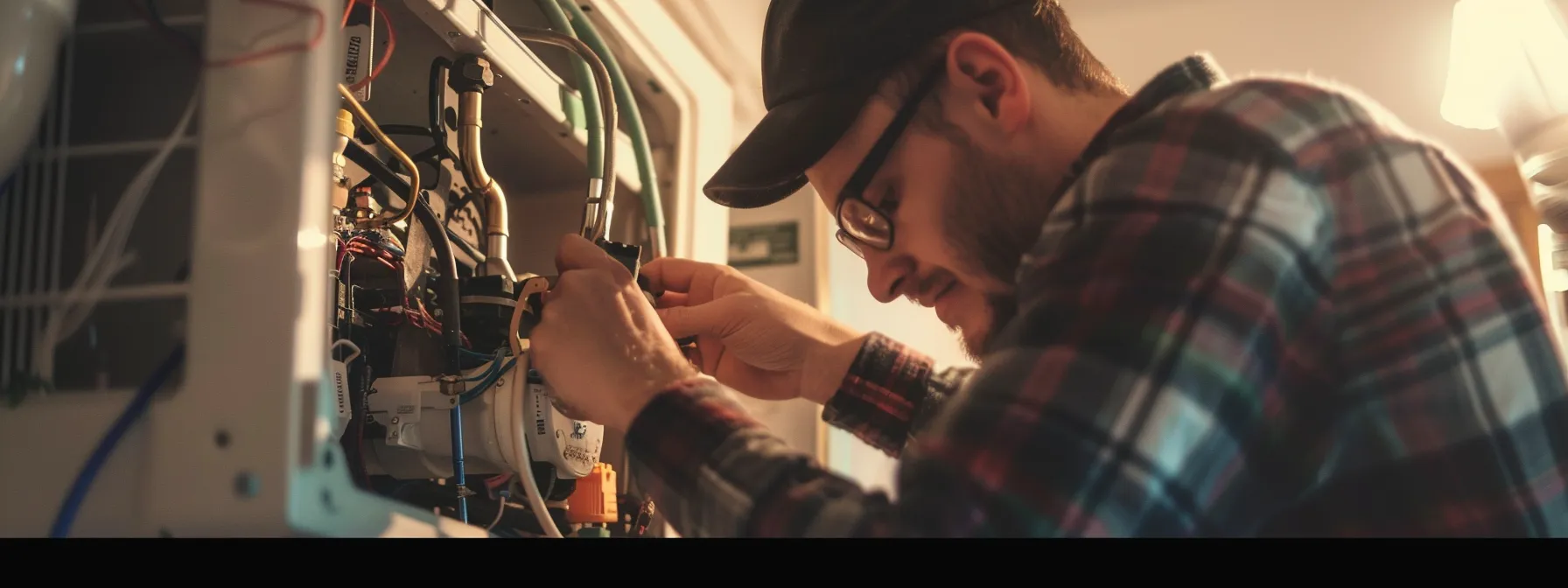
Hey there, let’s talk about why it’s super important to catch those furnace warning signs before winter rolls in. You don’t want your heating system bailing on you when it’s freezing outside, right?
Spotting issues early can save you from unexpected breakdowns, keep your home safe and cozy, and believe it or not, save you some cash by fixing things up before they get worse.
We’ll look at how to prevent a cold home disaster, why your safety during the chilly months is a big deal, and how early repairs can be kinder to your wallet.
So, keep an eye on your air conditioning, thermostat, plumbing, ducts, and watch out for that sneaky gas leak – they’re all part of the puzzle.
Preventing Unexpected Heating System Failures
Imagine it’s the first cold snap of the season and you crank up the heat, only to find your furnace is on the fritz. Not fun, right? That’s why keeping an eye on your furnace’s health is key.
A clogged air filter, for instance, can strain your system and lead to a full-on failure. Regular checks and timely replacementscan keep the warm air flowing without a hitch.
And let’s not forget about the refrigerant levels and heat exchanger – these need to be just right to avoid a mid-winter meltdown.
Now, you might not think much about heating services, but these are great for your furnace. A flickering pilot light could signal a deeper issue, like a faulty thermocouple, while a noisy pump might be crying out for a repair or replacement.
By staying alert to these signs, you’re not just ensuring a warm home; you’re dodging the bullet of emergency repair costs and the hassle of last-minute service calls:
| Component | Warning Sign | Action to Take |
|---|---|---|
| Air Filter | Clogged or dirty | Replace or clean filter |
| Refrigerant | Low levels | Recharge refrigerant |
| Heat Exchanger | Cracks or rust | Inspection and repair |
| Pilot Light | Flickering or yellow flame | Check thermocouple or gas supply |
| Pump | Noisy operation | Repair or replace pump |
Ensuring Safety and Comfort During Cold Months
When the mercury drops, the last thing you need is a furnace that’s not up to snuff. A faulty flame sensor or a carbon monoxide leak could put you and your family at risk, turning your cozy retreat into a danger zone.
You’ve got to keep an eye out for the silent threats like carbon buildup or an unusual noise that could signal big trouble. It’s not just about staying warm; it’s about staying safe.
Let’s not forget the impact on your wallet, either. A furnace acting up can guzzle more electricity or water than it should, hiking up your bills faster than you can say ‘winter is coming’.
By spotting those early warning signs – a weak flame, strange noises, or a sudden spike in your utility bills – you’re not just ensuring a warm, safe home; you’re also keeping your energy costs in check.
Saving Money Through Early Repairs
Getting ahead of furnace issues isn’t just about avoiding the shivers; it’s about keeping your hard-earned money in your pocket.
When you tackle repairs early, you’re promoting energy conservation, which means your system won’t have to work as hard.
This translates to lower energy bills and more cash for those holiday treats. Plus, regular maintenance from our heating services can extend the life of your furnace, saving you from the hefty cost of a full replacement down the line.
Think about it – a well-maintained furnace burns fuel more efficiently. Whether you’re using natural gas or another type of combustion, a smooth-running system means you’re getting the most bang for your buck with our heating services.
And let’s not overlook indoor air quality; a furnace in tip-top shape keeps the air in your home cleaner, which is a win for your health and your wallet. So, don’t wait for the winter chill to bite; a little attention now can lead to big savings later.
As winter’s chill approaches, knowing the signs of a faltering furnace can save you from the cold’s unforgiving grip. Listen closely – the clanks and whirs from your furnace are not just noises, they’re cries for help.
Unusual Noises That Indicate Your Furnace Needs Repair
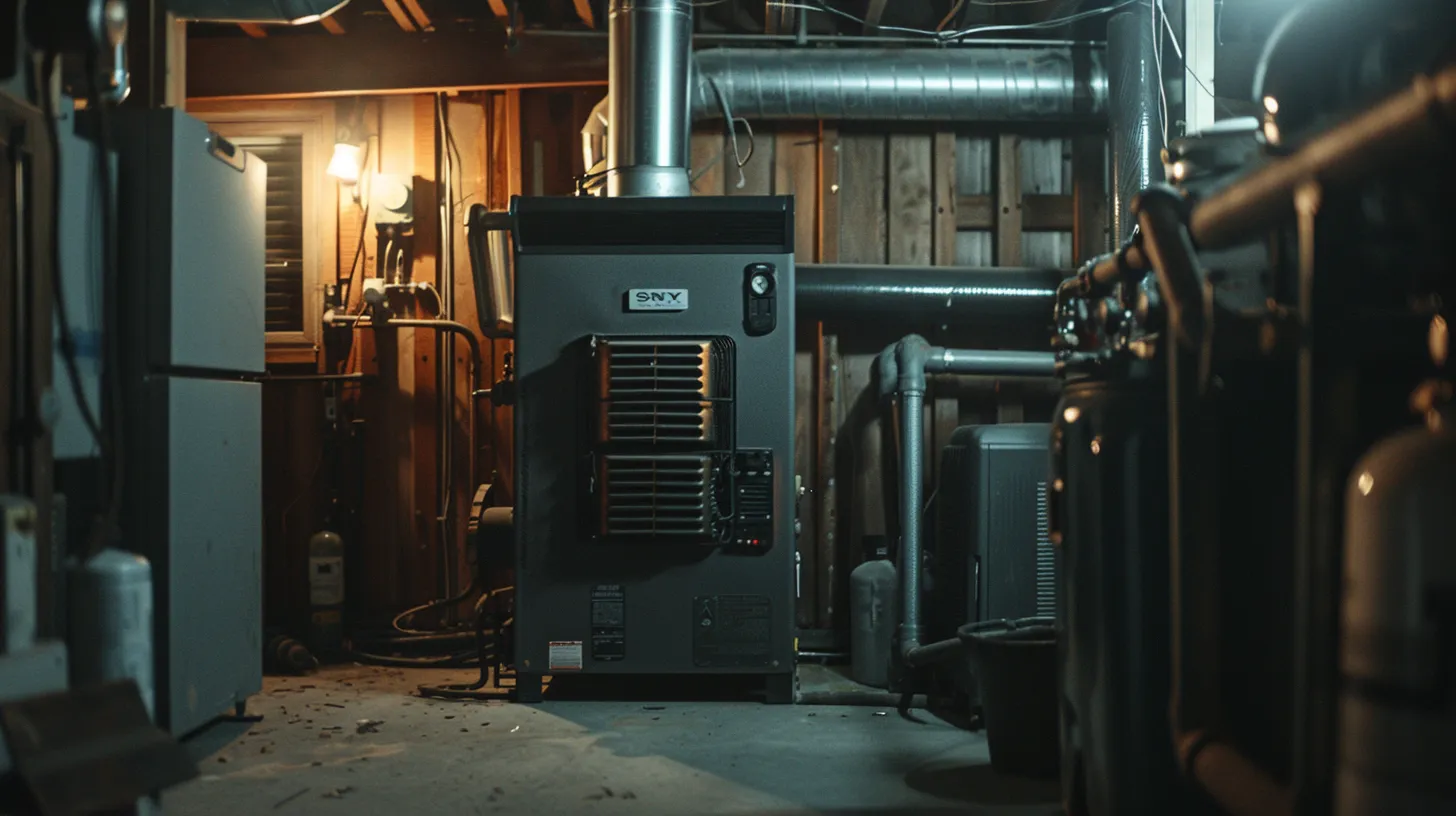
If your furnace starts serenading you with banging, whistling, or squealing, it’s not trying to charm you – it’s a cry for help. These sounds can clue you in on issues ranging from a simple fix to a serious safety hazard.
You’ll want to understand what’s causing the racket and know the right steps to take. Whether it’s a wonky heater core or an odor that has you reaching for the carbon monoxide detector, addressing these noises promptly can save you stress and cost down the road.
Let’s get to the bottom of these noises and keep your boiler running smoothly with our heating services.
Recognizing Banging, Whistling, or Squealing Sounds
When your heating system starts to make a racket, it’s time to listen up. Banging could mean there’s a buildup of dust and debris causing a blockage, while whistling often points to a leak in your system‘s coolant line.
These sounds are your furnace‘s way of saying, “Hey, I need some TLC over here!” Ignoring these cries for help could lead to bigger issues, like a compromised radiator or a fuel inefficiency that’ll hit your pocket hard.
If you encounter any of these issues, contact a professional HVAC company for expert heating services.
Now, if you hear a high-pitched squeal, that’s a sign something might be off with the blower belt or motor bearings. It’s like your car telling you it’s time for an oil change: you know you better not wait too long.
Getting these heating services components checked out by a professional can prevent a small hiccup from turning into a full-blown system meltdown. Here’s a quick guide to help you decode those furnace sounds:
| Noise | Possible Cause | Recommended Action |
|---|---|---|
| Banging | Dust buildup | Inspect and clean |
| Whistling | Coolant leak | Seal and recharge system |
| Squealing | Worn blower belt | Replace belt or lubricate bearings |
Understanding the Causes Behind the Noises
When your heating starts to sound like a garage band, it’s a sign that something’s not right inside your furnace.
These often means that components within your cooling system are wearing out or malfunctioning. Skilled HVAC technicians from a professional HVAC company can pinpoint the issue, whether it’s a belt that’s lost its tension or a blower fan that’s seen better days.
They’ll get your central air and heating humming quietly again, ensuring your comfort and peace of mind as the temperatures drop.
Don’t ignore those groans and squeaks coming from your furnace; they’re not just annoying, they’re a call to action. A well-timed heating services can transform a noisy, inefficient system into a silent, smooth operator.
Remember, your central air system works hard to keep you warm, so give it the attention it deserves. Quick fixes now can prevent a cold, costly reality check when winter hits full force.
Steps to Take When You Hear Strange Sounds
So, you’ve noticed your air conditioner making a symphony of odd noises, and you’re wondering what to do next, right? First things first, don’t panic. It’s time to play detective with your HVAC system.
Shut it down to prevent further damage and take a moment to listen closely. Is it a clunk, a whistle, or a screech? Identifying the sound can give you a clue about what’s going wrong: a clunk might mean a loose part, while a screech could signal a belt issue.
And remember, if you’re not sure, it’s always best to call in an expert for a thorough check-up.
Now, let’s get down to business: here’s what you should do when your furnace starts to sound like it’s throwing a tantrum:
- Turn off your HVAC system to avoid further damage.
- Check for any visible signs of wear or damage to your air conditioner or furnace.
- Contact a trusted HVAC contractor for a professional diagnosis.
If it’s a serious issue, like you suspect a gas leak or there’s an emergency water heater repair needed, don’t hesitate to reach out for immediate help.
It’s better to tackle these issues head-on than to wait for a furnace replacement in the dead of winter. Stay warm, stay safe, and let’s keep those strange noises out of your cozy home.
Now, you’ve got a handle on those strange sounds your furnace has been making.
Signs of Inefficient Heating Performance to Watch For
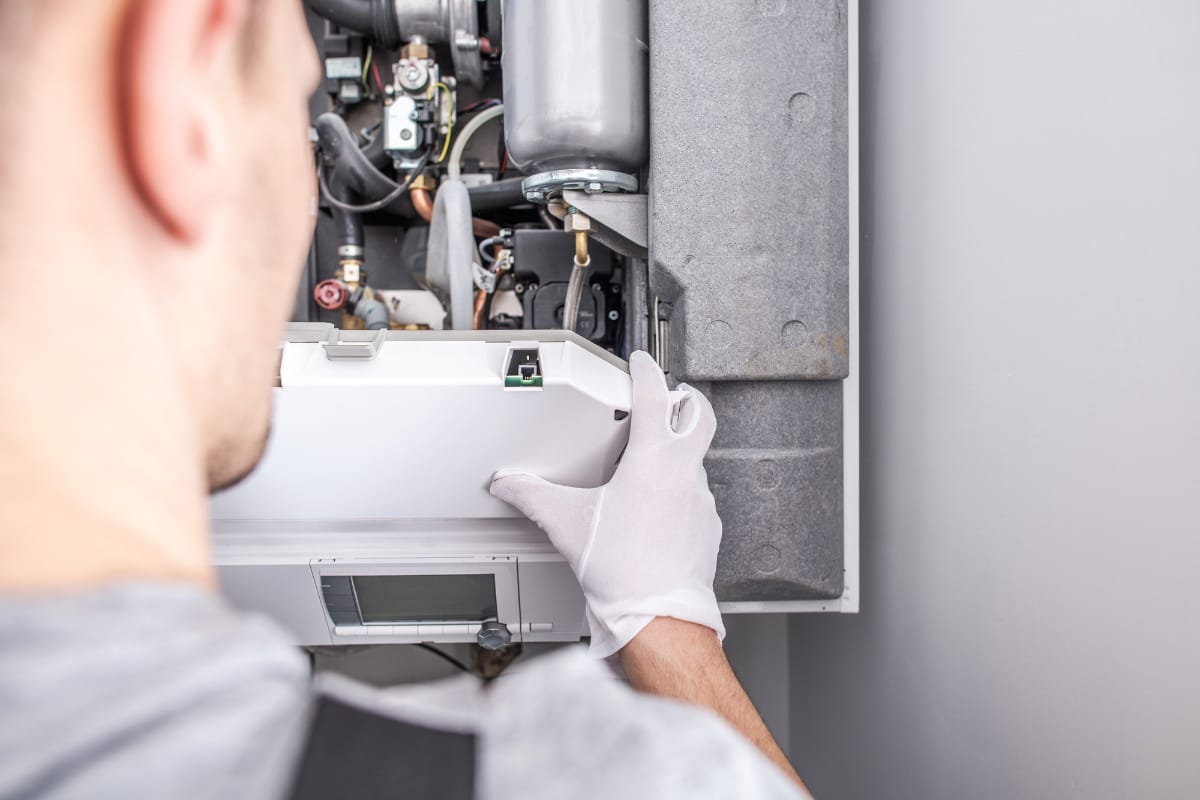
Noticing your home feels a bit chillier than usual, or your energy bills are creeping up without reason? These could be telltale signs that your furnace isn’t performing efficiently.
If you’re facing inconsistent warmth, rising costs, or weak airflow from your vents, it might be time to consider an expert for an emergency heating repair or even a gas furnace replacement.
Keep an eye out for these red flags, as they could indicate blockages or the need for a 24-hour furnace repair or gas water heater repair. Let’s dive into what these signs mean for your heating services needs.
Inconsistent or Insufficient Warmth in Your Home
If you’re noticing that some rooms in your home are toasty while others are more like iceboxes, it’s a red flag that your heating system might be on the fritz.
This inconsistent warmth can be a sign that your furnace needs some attention, and it’s a common issue that furnace companies encounter. Before you’re left shivering for extra blankets, consider reaching out for heating services. It’s a smart move to ensure your home stays evenly heated throughout those colder months.
On the flip side, if cranking up the thermostat doesn’t banish the chill, your furnace may not be producing enough heat. This insufficient warmth could mean it’s time for some hot water heater maintenance or AC heater repair by a professional HVAC company.
Don’t wait until you can see your breath indoors; HVAC repairs done sooner rather than later can save you from the deep freeze and keep your winter wonderland strictly outside where it belongs.
Rising Energy Bills Without Increased Usage
If you’ve noticed your energy bills creeping up without cranking the heat, it’s a red flag that your furnace might be losing its efficiency.
This could be due to a struggling compressor or a condenser that’s seen better days, forcing your system to work overtime and guzzle more energy. It’s like your furnace is trying to run a marathon with a sprained ankle – it’s going to use more energy to get the job done.
Another culprit could be a clogged evaporator or an oil furnace needing a tune-up. These issues can cause your system to work harder, leading to higher bills.
If you’re dealing with a spike in costs, it’s worth getting it checked out. You might just catch a problem like a carbon monoxide leak early, which not only protects your wallet but also keeps you safe.
Poor Airflow From Vents Indicating Blockages
Ever walked past a vent and felt only a whisper of warmth instead of a hearty flow of hot air? That’s a classic sign your furnace might be struggling with blockages.
Regular furnace maintenance is crucial to prevent this, as dirt and debris can accumulate over time, restricting airflow and forcing your system to work harder.
This not only leaves you with cold air creeping into your home but can also lead to premature wear and the need for repairs or even a full replacement.
Don’t let a weak breeze from your vents become the norm. Heating services can swiftly identify and clear out any blockages, ensuring your system is ready to combat the winter chill. Here’s what you should keep an eye on to maintain a steady and strong airflow:
- Check and replace your furnace filters regularly.
- Schedule annual furnace maintenance to catch potential issues early.
- Be alert to any unusual sounds or smells that could indicate a blockage.
Taking these steps can help you avoid the hassle of unexpected furnace repairs and keep your home toasty all winter long.
Strange Odors Coming From Your Furnace

When your furnace starts giving off odd smells, it’s time to sit up and take notice. Burning scents could point to an urgent need to schedule furnace repair, while a gas-like odor means you should act fast and replace any faulty parts.
Musty smells? They’re a heads-up that mold or mildew might be crashing your cozy space. Each whiff is a clue, and we’re here to decode them for you.
Identifying Burning Smells and Their Implications
If you catch a whiff of something burning and it’s not your dinner, it could be a sign that your furnace is having a meltdown. This burning smell often means there’s an electrical issue or a component overheating, which can lead to a full-blown furnace problem.
It’s a clear signal to get on the phone with an HVAC company before you’re left in the cold, or worse, dealing with a heating system replacement.
Now, if the air conditioning air coming through your vents carries a hint of something scorched, don’t shrug it off. This could indicate that parts within your furnace are wearing out or that there’s a serious wiring issue.
Quick tips to keep in mind: check your filters first, as a dirty filter can cause overheating, and if the smell persists, it’s time to call in the professionals. They’ll help you figure out if it’s a simple fix or if you’re looking at a bigger furnace problem.
Detecting Gas-Like Odors and Taking Immediate Action
If you catch a whiff of something that smells like gas coming from your air conditioning system, it’s a red flag that demands immediate attention. This isn’t something to shrug off or add to your weekend to-do list; it’s a potential safety hazard that requires urgent HVAC repair.
Gas odors suggest there could be a leak, which is serious business. Shut down your equipment right away and call in the pros to check it out. You’re better off safe than sorry, especially when it comes to the equipment that keeps your home warm.
Remember, your air conditioning heating system is complex, and gas leaks are nothing to mess with. They can lead to dire consequences if not addressed promptly. If you’re smelling gas, don’t try to fix it yourself by poking around or replacing parts.
This is a job for skilled technicians who know exactly what to look for and how to fix it safely. So, if your nose tells you something’s off, trust it and get that HVAC repair service on the line ASAP.
Musty Smells Signaling Mold or Mildew Issues
When a musty smell wafts from your vents, it’s a red flag that mold or mildew might be gatecrashing your airflow, and it’s not just a hit to your nose – it can impact your health.
This odor often points to excess moisture in your system, which can shorten the life expectancy of your furnace and mess with its sensors. Quick troubleshooting from a professional can save you from a utility nightmare and keep your furnace running efficiently.
Don’t let that damp, earthy scent linger; it’s a telltale sign that a professional needs to take a look. Mold and mildew thrive in dark, moist environments, and if they’re hanging out in your ducts, they’re compromising your indoor air quality. Here’s what you should do to tackle the issue head-on:
- Replace your furnace filter to ensure proper airflow and prevent spores from circulating.
- Have a professional inspect your ductwork for leaks that could be contributing to moisture buildup.
- Consider a dehumidifier to keep your home’s humidity levels in check, discouraging mold growth.
Addressing these issues promptly not only clears the air but also preserves the longevity of your HVAC system. So, take action at the first sniff of trouble to maintain a fresh and healthy home environment.
Frequent Cycling or Difficulty Starting the Furnace
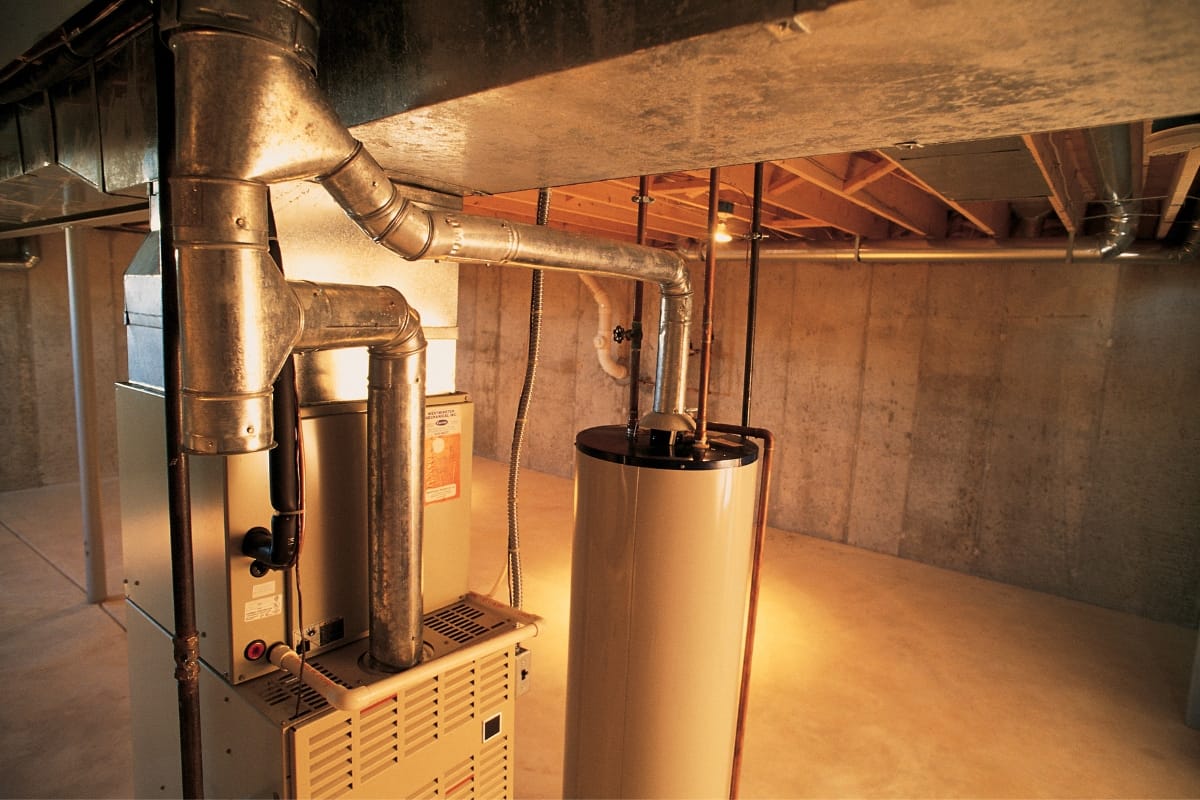
Is your furnace playing hot and cold, turning on and off more than it should? This frequent cycling could be a warning sign that something’s not right.
Maybe it’s rust eating away at components, or a fire hazard lurking in the shadows. It’s time to troubleshoot. Don’t wait until you’re left in the cold; understanding these issues is key to maintaining your system‘s efficiency.
When these signs pop up, it might be time to call in the pros for a heating services repair, especially if your warranty‘s still got your back.
Causes of the Furnace Turning on and Off Repeatedly
When your furnace starts turning on and of frequently, it’s a sign that your central heating might be in distress.
This frequent cycling can be caused by an overly dirty air filter, which restricts airflow and tricks your furnace into thinking it’s done its job too soon. It could also be a thermostat issue, where the device is misreading indoor temperatures and sending mixed signals to your heating system.
You don’t want to be caught in an emergency situation when the winter chill hits, so keep an eye out for these erratic behaviors. For heating services, contact us for assistance.
Another culprit behind this start-stop dance could be a clogged blower or issues with the furnace‘s flame sensor. If you’re noticing soot around the furnace or a lack of heat, it’s time to investigate.
Soot indicates incomplete combustion, often due to a problem with the heating oil or the burners themselves. And if you’ve recently installed a humidifier and the cycling started soon after, it’s worth checking if it’s impacting the furnace‘s performance. Here’s a quick guide to help you understand what might be causing the frequent cycling:
| Issue | Possible Cause | Immediate Action |
|---|---|---|
| Frequent Cycling | Dirty air filter or thermostat issue | Replace filter or check thermostat |
| Soot Buildup | Incomplete combustion, heating oil issue | Inspect burners and fuel quality |
| Impact from Humidifier | Humidifier affecting furnace sensors | Check humidifier settings and furnace response |
Troubleshooting a Furnace That Won’t Start Easily
If your furnace is playing hard to get and won’t start without a fuss, it’s time to give it some attention. First, check your circuit breaker to make sure a simple flip isn’t the quick fix you need.
If that’s not the culprit, it could be an issue with the ignition system or a valve that’s not opening properly.
These are signs your furnace is begging for repair, and ignoring them could leave you in the cold when the humidity drops and you need your heating services most.
Now, if you’ve got an air purifier or other systems linked to your HVAC heating, they could be influencing your furnace‘s performance. Make sure everything’s in sync and that your air purifier isn’t adding extra strain on your furnace.
Sometimes, the solution is as straightforward as checking these connections and ensuring they’re not the reason your furnace is struggling to kick into gear. Remember, a little detective work now can save you a heap of trouble when winter’s chill is knocking at your door.
When to Seek Professional Heating System Repair
If you’re noticing your furnace kicking on and off, or if it’s throwing a fit before starting up, it’s high time to call in the professionals.
Especially if you’ve checked the basics – like the fuse box – and everything seems in order. A professional can assess the pressure levels and ventilation to ensure your basement stays warm and your system runs smoothly.
They’ve got the know-how to spot issues you might miss, like a clogged drain or draft that’s messing with your furnace‘s mojo.
Let’s say you’ve done all the right things – you’ve kept an eye on the filter, made sure the thermostat is set correctly, and yet, your furnace is still acting up. That’s your cue to reach out for expert help.
They’ll dive into the nitty-gritty, checking things like the pilot light and the integrity of your ventilation system. When it comes to keeping your home cozy and your family safe, getting a professional to take a look at our heating services is worth its weight in gold – or at least in warm, comfy evenings spent in your snug living room.
Your furnace‘s frequent stops and starts are a telltale heartbeat of distress. Look closer, and the signs of a weary machine come into sharp focus.
Visible Signs Your Furnace Needs Attention
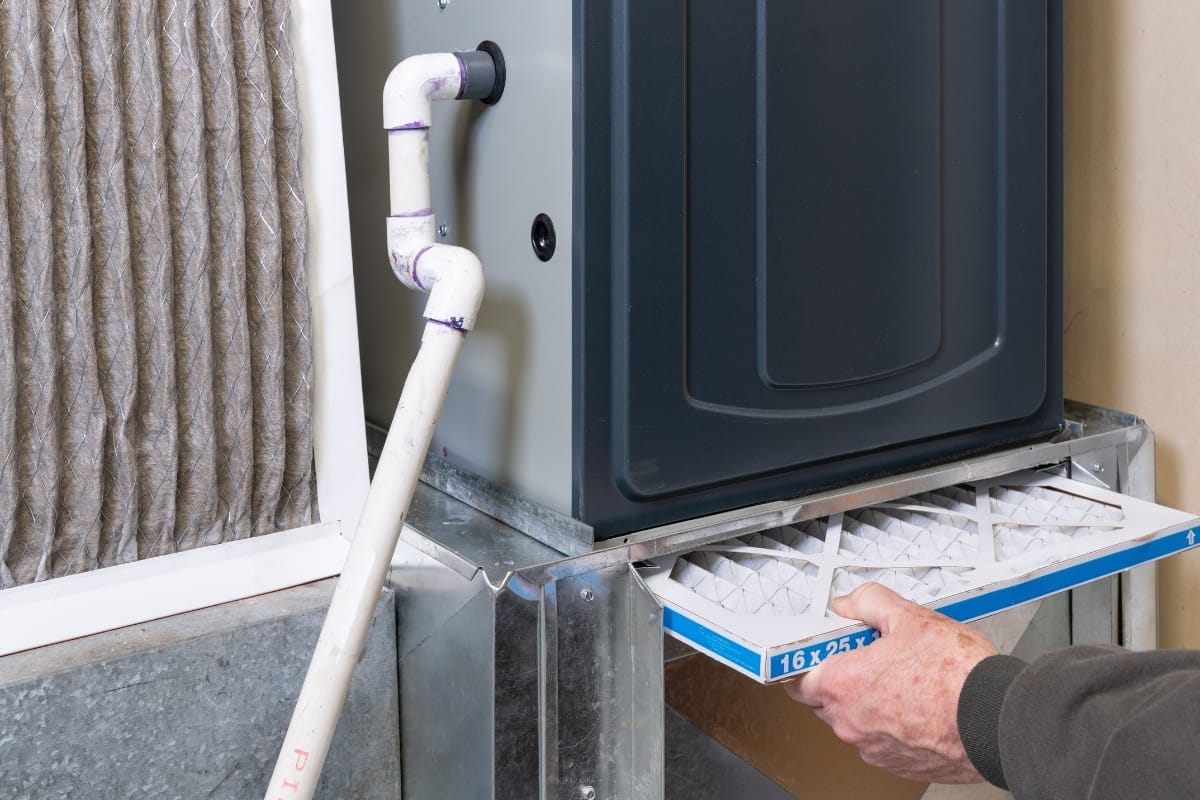
Hey, have you spotted rust, cracks, or corrosion on your furnace? Or maybe there’s a pile-up of dust or soot that’s hard to miss? These visible signs are your furnace waving a red flag, signaling it’s time for a thorough inspection.
Addressing these issues promptly can prevent a small hiccup from becoming a full-blown, costly repair. So, let’s get into why keeping your furnace clean, especially around the pipe and condenser unit, is crucial for a light, warm winter.
Noticing Rust, Cracks, or Corrosion on the Unit
Hey, if you’ve caught sight of rust, cracks, or corrosion on your furnace, it’s like your heating system is sending you an SOS. These signs can mean it’s battling moisture or age-related wear, which can mess with its efficiency.
It’s crucial to get these issues checked out, because they can lead to bigger problems with your conditioner or carrier system, and nobody wants that when the cold weather hits.
Think of weatherization programs that recommend regular inspections to catch these issues early. If you spot any of these red flags, it’s a smart move to reach out to a professional who can assess the damage and suggest the best course action.
This way, you can ensure your system is in top shape to keep your home warm and toasty all winter long:
| Sign | Potential Issue | Recommended Action |
|---|---|---|
| Rust | Moisture damage | Professional inspection |
| Cracks | Structural damage | Assess for repair or replacement |
| Corrosion | Age or chemical exposure | Evaluate system integrity |
Accumulation of Dust or Soot Around the Furnace
When you spot a layer of dust or soot around your furnace, it’s a clear sign that your system needs a check-up.
Buildup can force your furnace to work harder, leading to increased energy use and higher bills. Especially if you’re using a propane or water heater system, that extra strain can mean more wear and tear on your equipment. It’s like flipping a switch from efficient to energy-hogging mode, and that’s not what you want as the temperatures drop.
Don’t let that grime go unchecked; it could be hinting at a deeper issue, like a malfunctioning part that’s compromising your system‘s cleanliness and efficiency. If you’re noticing soot, it’s particularly urgent, as it could indicate incomplete combustion in your furnace, posing potential risks to your home.
A quick call to a professional can help you nip these problems in the bud, ensuring your furnace runs smoothly and keeps your space warm without unnecessary energy spikes.
The Importance of Addressing Physical Wear Promptly
When you spot wear and tear on your furnace, like a frayed hose or a rusty exhaust system, it’s a clear call to action. Ignoring these signs can lead to a buildup of dander and other allergens in your home, not to mention the risk of a sudden breakdown.
You don’t want to be scrambling for emergency service when the first frost hits, so let the experts give your system the once-over now to ensure it’s in peak condition for the cold months ahead.
Remember, the physical wear on your furnace isn’t just an eyesore; it can compromise the entire heating system. A crack in the heat exchanger or a leak in the exhaust system can be dangerous, allowing harmful gases to enter your living space.
Acting swiftly not only secures your comfort but also your safety. Trust professionals to expertly handle these heating services, ensuring your furnace runs efficiently and keeps your home warm all winter long.
Frequently Asked Questions
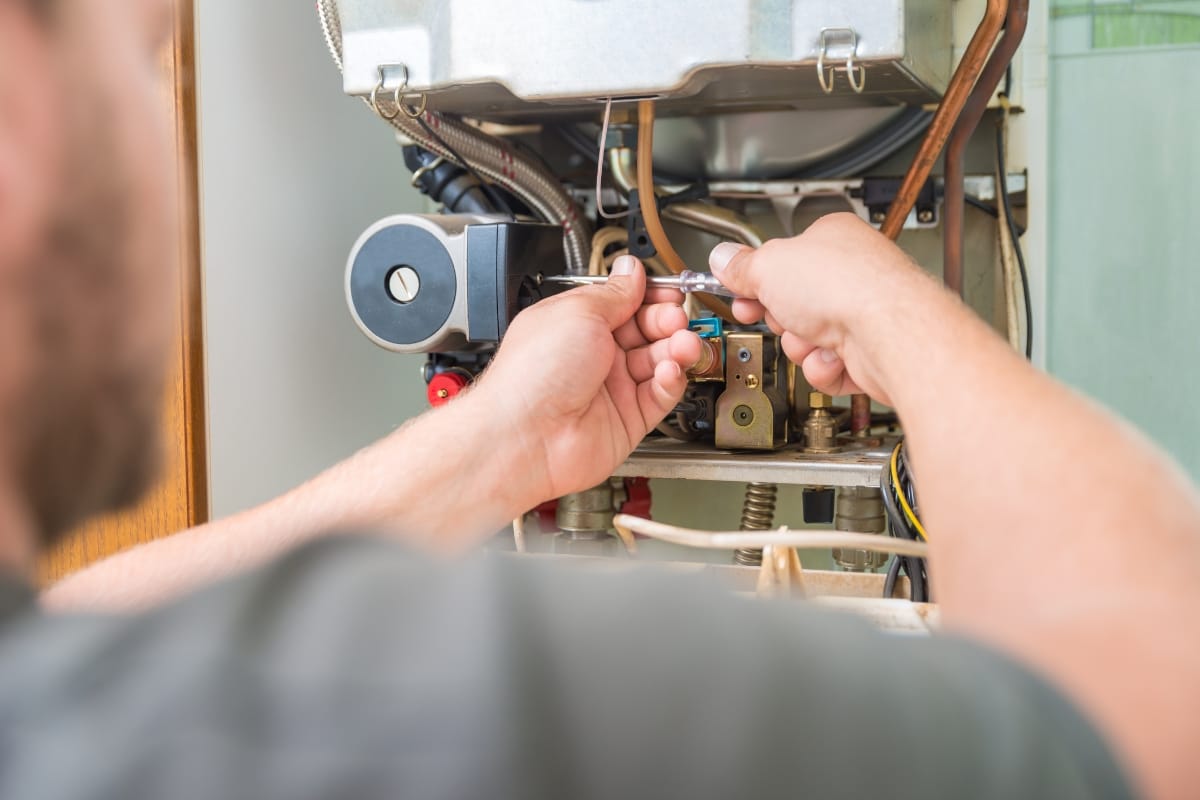
What are the critical signs my furnace needs repair before winter?
If your furnace emits strange noises, struggles to heat, or hikes up energy bills, it’s time for a professional inspection to avoid chilly surprises.
Which noises from my furnace suggest it needs a repair?
If your furnace is making banging, whistling, or rattling noises, it’s time to consider a professional repair to ensure safety and efficiency.
How can I tell if my furnace isn’t heating efficiently?
If your furnace is struggling to maintain warmth, showing increased energy bills, or emitting strange noises, it might not be heating efficiently.
What do strange smells from my furnace indicate?
Unusual smells from your furnace could signal a dirty filter, a burnt component, or even a dangerous gas leak, necessitating immediate professional inspection.
Why does my furnace keep turning on and off frequently?
Your furnace might be short cycling, a common issue often due to a dirty air filter, faulty thermostat, or an oversized system needing professional HVAC service.
Conclusion
As winter approaches, recognizing the warning signs of a failing furnace is crucial for maintaining a warm and safe home. Don’t let unexpected furnace issues leave you in the cold this winter.
If you’ve noticed any signs that your furnace might need repair, trust the experts at CoolPro Heating & Cooling to ensure your home stays warm and comfortable all season long.
Contact us today at 770-694-6232 or schedule a repair or consultation. Let CoolPro Heating & Cooling handle your heating needs with expertise and reliability!

